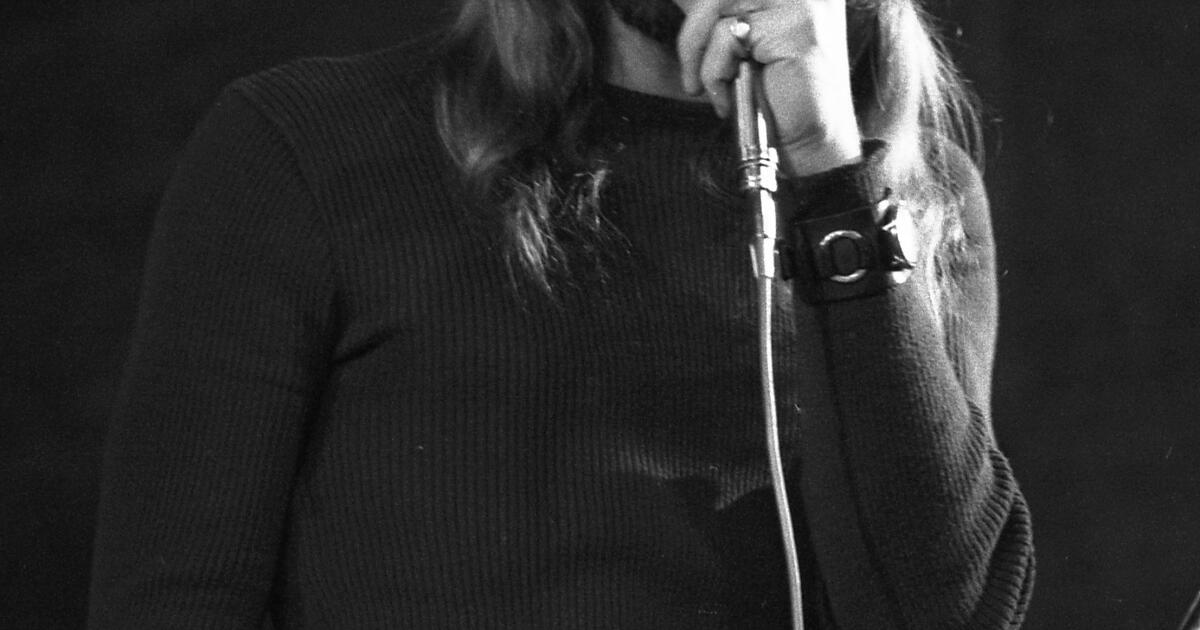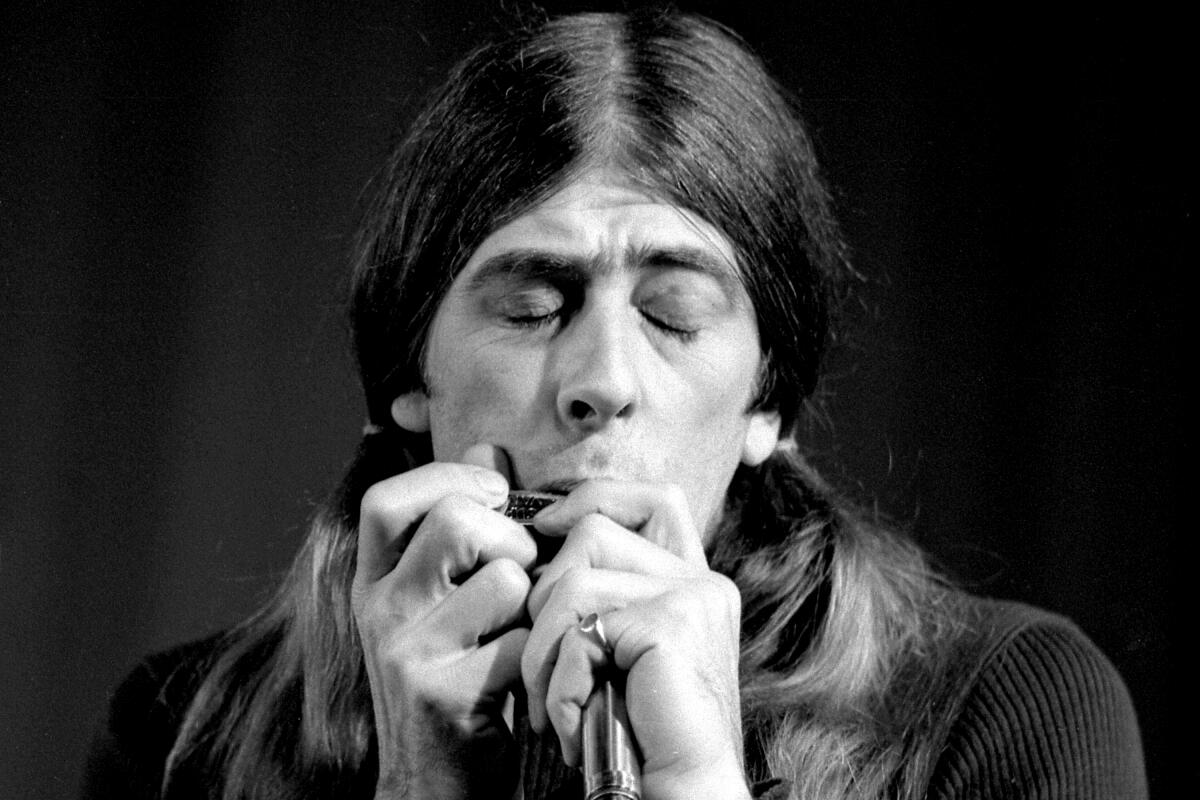Entertainment
Appreciation: John Mayall set the bar for the British blues explosion by leading with heart and soul

As a kid growing up on the outskirts of Manchester, England, John Mayall recognized something personal in the blues records coming over from the United States. He heard joy, agony and stories from real life, all of it set to music that could be euphoric and downtrodden, hopeful and mysterious.
It was music of profound emotion that would stay with him forever, and as a leading purveyor of that tradition in the British blues explosion of the 1960s, he represented a standard for many better-known players to follow. “He was my mentor and a surrogate father too,” Eric Clapton said in a tribute posted Wednesday on Instagram. “He taught me all I really know and gave me the courage and enthusiasm to express myself without fear or without limit.”
Mayall, who died this week at age 90, provided a home to an astonishing lineup of virtuosic players who passed through his band the Bluesbreakers en route to greater fame later: Clapton and Jack Bruce (who formed Cream), Mick Taylor (later of the Rolling Stones) and members of Fleetwood Mac, Journey, Canned Heat and more.
John Mayall was a mentor to Eric Clapton, Mick Fleetwood and many other superstars.
(Claus Hampel / Associated Press)
He was a half-generation older than many of the iconic players he nurtured, and an important source of inspiration. He gave refuge to a disheartened Clapton, who had just quit the Yardbirds and was considering leaving music entirely. But the fame that many of Mayall’s endlessly rotating sidemen later enjoyed was entirely beside the point to him.
“The great roster of the most famous names all came out of that period of London of four or five years,” he told me in 1997. “Everybody knew everybody, so they were shifting around, finding their own musical path. As a band leader I just hired whoever turned me on. That criteria is the same today as always.”
Back in the 1990s, I interviewed Mayall a few times, including at his house in the San Fernando Valley. Our very first talk on the phone was cut short by him after about 15 minutes, probably from my own inexperience as an interviewer and for asking too many questions about his more controversial statements. (Like calling Led Zeppelin “a parody of the blues.”)
But he was normally a patient proselytizer of the blues. While his own reputation often rested with his role as a profoundly gifted scout of talent, his own records showed a steady commitment to what had first inspired him. Mayall was a singer and multi-instrumentalist (harmonica, keyboards, guitar), and like his heroes, the songs he wrote were autobiographical — celebrations and laments about his life experiences.

John Mayall in 2013 at the Classic Rock Roll of Honor Awards show in London.
(Joel Ryan / Invision/Associated Press)
He was sometimes criticized as a purist who rarely wavered, even as former collaborators won accolades and made hit records by straying into rock, psychedelia and pop. If anything, his experiments went further away from the masses with a jazz-rock fusion sound on 1968’s “Bare Wires.” He stretched out with layers of horns and flute, he went solo acoustic, but the electrified Chicago blues was always his North Star.
“‘Purist’ is a funny word really, because it can mean someone who doesn’t want to shift from doing note-for-note copies of stuff other people have done in the early days,” he said. “There are bands that just do that. They consider themselves blues purists. But I’ve always been an innovator, so purist doesn’t really fit.
“I do draw from the pure roots of the blues to make something that’s very contemporary and something that is very personal.”
He grew up in the late-1940s and ’50s listening to his father’s vast record collection, learning to love the Mills Brothers, Charlie Christian and Lonnie Johnson, and was soon saving up to buy his own 78 rpm discs. “Anything with the word ‘boogie’ on it, I bought it,” Mayall told me. He then discovered the immortal blues played by Big Bill Broonzy, Blind Lemon Jefferson and Sonny Terry.
He was already 30 when he left Manchester for London, after a career in typography and art, ready to join the blues scene rising there. “It all really happened rather suddenly, and everybody really came down to London,” he said. “The Animals came down from Newcastle, Spencer Davis and Stevie Winwood came from Birmingham. If you wanted to play you really had to start off and be based in London. So that’s what I did.”
The British blues scene was kicked off by Alexis Korner and Cyril Davis, evolving from folk clubs to electrified Chicago blues. As it had for Mayall, American blues had reached the postwar generation on the British Isles and ignited a movement, even as blues was still underappreciated back in the U.S. It would take a British invasion of inspired young players to bring it back home.

Mayall was a singer and multi-instrumentalist (harmonica, keyboards, guitar), and like his heroes, the songs he wrote were autobiographical — celebrations and laments about his life experiences.
(Claus Hampel / Associated Press)
In those early days, Mayall was encouraged by successes of the early Rolling Stones and Yardbirds. “I was pretty amazed, because I had been playing this music privately for 15-20 years and knew what it was all about. But I’d never dreamed it was fit for public consumption, so to speak,” he said. “I owed it to myself to give it a shot.”
His best-known album, 1967’s “Blues Breakers With Eric Clapton,” is considered a classic document of that scene, and an early sign of Clapton’s still evolving skills. Mayall otherwise had no major pop hits, and few accolades for most of his life other than a couple of Grammy nominations. In 2005 he was awarded an OBE (Officer of the Order of the British Empire) by Queen Elizabeth II, and this fall was to be inducted into the Rock and Roll Hall of Fame with an Influence Award.
At times during interviews, he would grumble about a lack of recognition, but his focus remained on the work ahead — spending a third of the year on the road, and releasing nearly 40 studio albums and more than 30 live recordings in his lifetime. For him, his musical journey remained always open-ended, right up until his last performance in February 2022 in San Juan Capistrano.
“Creating music is an art,” he explained. “Jazz musicians and blues musicians, their careers do not end except by death. It’s something that has a built-in longevity. It’s not a flash-in-the-pan thing. The years only make you more mature, you learn more and more as the years go by.”

Movie Reviews
Movie Review: A real-life ’70s hostage drama crackles in Gus Van Sant’s ‘Dead Man’s Wire’
It plays a little loose with facts but the righteous rage of “Dog Day Afternoon” is present enough in Gus Van Sant’s “Dead Man’s Wire,” a based-on-a-true-tale hostage thriller that’s as deeply 1970s as it is contemporary.
In February 1977, Tony Kiritsis walked into the Meridian Mortgage Company in downtown Indianapolis and took one of its executives, Dick Hall, hostage. Kiritsis held a sawed-off shotgun to the back of Hall’s head and draped a wire around his neck that connected to the gun. If he moved too much, he would die.
The subsequent standoff moved to Kiritsis’ apartment and eventually concluded in a live televised news conference. The whole ordeal received some renewed attention in a 2022 podcast dramatization starring Jon Hamm.
But in “Dead Man’s Wire,” starring Bill Skarsgård as Kiritsis, these events are vividly brought to life by Van Sant. It’s been seven years since Van Sant directed, following 2018’s “Don’t Worry, He Won’t Get Far on Foot,” and one of the prevailing takeaways of his new film is that that’s too long of a break for a filmmaker of Van Sant’s caliber.
Working from a script by Austin Kolodney, the filmmaker of “My Own Private Idaho” and “Good Will Hunting” turns “Dead Man’s Wire” into not a period-piece time capsule but a bracingly relevant drama of outrage and inequality. Tony feels aggrieved by his mortgage company over a land deal the bank, he claims, blocked. We’re never given many specifics, but at the same time, there’s little doubt in “Dead Man’s Wire” that Tony’s cause is just. His means might be desperate and abhorrent, but the movie is very definitely on his side.
That’s owed significantly to Skarsgård, who gives one of his finest and least adorned performances. While best known for films like “It,” “The Crow” and “Nosferatu,” here Skarsgård has little more than some green polyester and a very ’70s mustache to alter his looks. The straightforward, jittery intensity of his performance propels “Dead Man’s Wire.”
Yet Van Sant’s film aspires to be a larger ensemble drama, which it only partially succeeds at. Tony’s plight is far from a solitary one, as numerous threads suggest in Kolodney’s fast-paced script. First and foremost is Colman Domingo as a local DJ named Fred Temple. (If ever there were an actor suited, with a smooth baritone, to play a ’70s radio DJ, it’s Domingo.) Tony, a fan, calls Fred to air his demands. But it’s not just a media outlet for him. Fred touts himself as “the voice of the people.”
Something similar could be said of Tony, who rapidly emerges as a kind of folk hero. As much as he tortures his hostage (a very good Dacre Montgomery), he’s kind to the police officers surrounding him. And as he and Dick spend more time together, Dick emerges as a kind of victim, himself. It’s his father’s bank, and when Tony gets M.L. Hall (Al Pacino) on the phone, he sounds painfully insensitive, sooner ready to sacrifice his son than acknowledge any wrongdoing.
Pacino’s presence in “Dead Man’s Wire” is a nod to “Dog Day Afternoon,” a movie that may be far better — but, then again, that’s true of most films in comparison to Sidney Lumet’s unsurpassed 1975 classic. Still, Van Sant’s film bears some of the same rage and disillusionment with the meatgrinder of capitalism as “Dog Day.”
There’s also a telling, if not entirely successful subplot of a local TV news reporter (Myha’la) struggling against stereotypes. Even when she gets the goods on the unspooling news story, the way her producer says to “chop it up” and put it on air makes it clear: Whatever Tony is rebelling against, it’s him, not his plight, that will be served up on a prime-time plate.
It doesn’t take recent similar cases of national fascination, such as Luigi Mangione, charged with killing a healthcare executive, to see contemporary echoes of Kiritsis’ tale. The real story is more complicated and less metaphor-ready, of course, than the movie, which detracts some from the film’s gritty sense of verisimilitude. Staying closer to the truth might have produced a more dynamic movie.
But “Dead Man’s Wire” still works. In the film, Tony’s demands are $5 million and an apology. It’s clear the latter means more to him than the money. The tragedy in “Dead Man’s Wire” is just how elusive “I’m sorry” can be.
“Dead Man’s Wire,” a Row K Entertainment release, is rated R for language throughout. Running time: 105 minutes. Three stars out of four.
Entertainment
Disney+ to include vertical videos on its app

In a bid for greater user engagement, Walt Disney Co. will introduce vertical videos to its Disney+ app over the next year, a company executive said Wednesday.
The move is part of the Burbank media and entertainment company’s effort to encourage more frequent app usage, particularly on smartphones.
“We know that mobile is an incredible opportunity to turn Disney+ into a true daily destination for fans,” Erin Teague, executive vice president of product management, said during an onstage presentation in Las Vegas at the Consumer Electronics Show. “All of the short-form Disney content you want, all in one unified app.”
Teague said the company will evolve that capability over time to determine new formats, categories and content types.
Disney’s presentation also touched on its interest in artificial intelligence. Last month, San Francisco startup OpenAI said it had reached a licensing deal with Disney to use more than 200 of the company’s popular characters in its text-to-video tool, Sora. Under the terms of that deal, users will be able to write prompts that generate short videos featuring Disney characters and use ChatGPT images to create those characters’ visages. Some of those Sora-generated videos will be shown on Disney+, though the companies said the deal did not include talent likenesses or voices.
Disney also said it would invest $1 billion into the AI company.
Part of Disney’s move toward AI is to appeal to young Gen Alpha viewers, who are more comfortable with AI and “expect to interact with entertainment” instead of simply watching stories on the screen, Teague said.
“AI is an accelerator,” she said. “It’s why collaborations with partners like OpenAI are absolutely crucial. We want to empower a new generation of fandom that is more interactive and immersive, while also respecting human creativity and protecting user safety.”
Movie Reviews
Film review: IS THIS THING ON? Plus January special screenings

.
Is This Thing On?
Cinematic stories of disintegrating marriages are fairly commonplace—and often depressing emotional endurance tests, besides—so it’s interesting to see co-writer/director Bradley Cooper take this variation on the theme in a fresher direction. The unhappy couple in this place is Alex and Tess Novak (Will Arnett and Laura Dern), who decide matter-of-factly to separate. Then Alex impulsively decides to get up on stage at an open-mic comedy night, and starts turning their relationship issues into material. The premise would seem to suggest an uneven balance towards Alex’s perspective, but the script is just as interested in Tess—a former Olympic-level volleyball player who retired to focus on motherhood—searching for her own purpose. And the narrative takes a provocative twist when their individual sparks of renewed happiness lead them towards something resembling an affair with their own spouse. The screenplay faces a challenge common to movies about comedians in that Alex’s material, even once he’s supposed to be actively working on it, isn’t particularly good, and Cooper isn’t particularly restrained in his own supporting performance as the comic-relief buddy character (who is called “Balls,” if that provides any hints). Yet the two lead performances are terrific—particularly Dern, who nails complex facial expressions upon her first encounter with Alex’s act—as Cooper and company turn this narrative into an exploration of how it can seem that you’ve fallen out of love with your partner, when what you’ve really fallen out of love with is the rest of your life. Available Jan. 9 in theaters. (R)
JANUARY SPECIAL SCREENINGS
KRCL’s Music Meets Movies: Dig! XX @ Brewvies: As part of a farewell to Sundance, Brewvies/KRCL’s regular Music Meets Movies series presents the extended 20th anniversary edition of the 2004 Sundance documentary about the rivalry between the Dandy Warhols and Brian Jonestown Massacre as they chart different music-biz paths. The screening takes place at Brewvies (677 S. 200 West) on Jan. 8 @ 7:30 p.m., $10 at the door or 2-for-1 with KRCL shirt. brewvies.com
Trent Harris weekend @ SLFS: Utah’s own Trent Harris has charted a singular course as an independent filmmaker, and you can catch two of his most (in)famous works at Salt Lake Film Society. In 1991’s Rubin & Ed, two mismatched souls—one an eccentric, isolated young man (Crispin Glover), the other a middle-aged financial scammer—wind up on a comedic road trip through the Utah desert; 1995’s Plan 10 from Outer Space turns Mormon theology into a crazy science-fiction parody. Get a double dose of uncut Trent Harris weirdness on Friday, Jan. 9, with Rubin & Ed at 7 p.m. and Plan 10 from Outer Space at 9 p.m. Tickets are $13.75 for each screening. slfs.org
Rob Reiner retrospective @ Brewvies Sunday Brunch: Last month’s tragic passing of actor/director Rob Reiner reminded people of his extraordinary work, particularly his first handful of features. Brewvies’ regular “Sunday Brunch” series showcases three of these films this month with This Is Spinal Tap (Jan. 11), The Princess Bride (Jan. 18) and Stand By Me (Jan. 25). All screenings are free with no reservations, on a first-come first-served basis, at noon each day. brewvies.com
David Lynch retrospective @ SLFS: It’s been a year since the passing of groundbreaking artist David Lynch, and Salt Lake Film Society’s Broadway Centre Cinemas marks the occasion with some of his greatest filmed work. In addition to theatrical features Eraserhead (Jan. 11), Inland Empire (Jan. 11), Mulholland Dr. (Jan. 12), Twin Peaks: Fire Walk With Me (Jan. 14), Blue Velvet (Jan. 19) and Lost Highway (Jan. 19), you can experience the entirety of 2017’s Twin Peaks: The Return on the big screen in two-episode blocs Jan. 16 – 18. The programming also includes the 2016 documentary David Lynch: The Art Life. slfs.org
Death by Numbers @ Utah Film Center: Directed by Kim A. Snyder (the 2025 Sundance feature documentary The Librarians), this 2024 Oscar-nominated documentary short focuses on Sam Fuentes, survivor of a school shooting who attempts to process her experience through poetry. This special screening features a live Q&A with Terri Gilfillan and Nancy Farrar-Halden of Gun Violence Prevention Center of Utah, with Zoom participation by Sam Fuentes. The screening on Wednesday, Jan. 14 at 7 p.m. at Utah Film Center (375 W. 400 North) is free with registration at the website.
-

 Detroit, MI5 days ago
Detroit, MI5 days ago2 hospitalized after shooting on Lodge Freeway in Detroit
-

 Dallas, TX3 days ago
Dallas, TX3 days agoDefensive coordinator candidates who could improve Cowboys’ brutal secondary in 2026
-

 Technology2 days ago
Technology2 days agoPower bank feature creep is out of control
-

 Health4 days ago
Health4 days agoViral New Year reset routine is helping people adopt healthier habits
-

 Nebraska1 day ago
Nebraska1 day agoOregon State LB transfer Dexter Foster commits to Nebraska
-

 Politics4 days ago
Politics4 days agoDan Bongino officially leaves FBI deputy director role after less than a year, returns to ‘civilian life’
-

 Nebraska2 days ago
Nebraska2 days agoNebraska-based pizza chain Godfather’s Pizza is set to open a new location in Queen Creek
-

 Louisiana3 days ago
Louisiana3 days agoInternet company started with an antenna in a tree. Now it’s leading Louisiana’s broadband push.


















